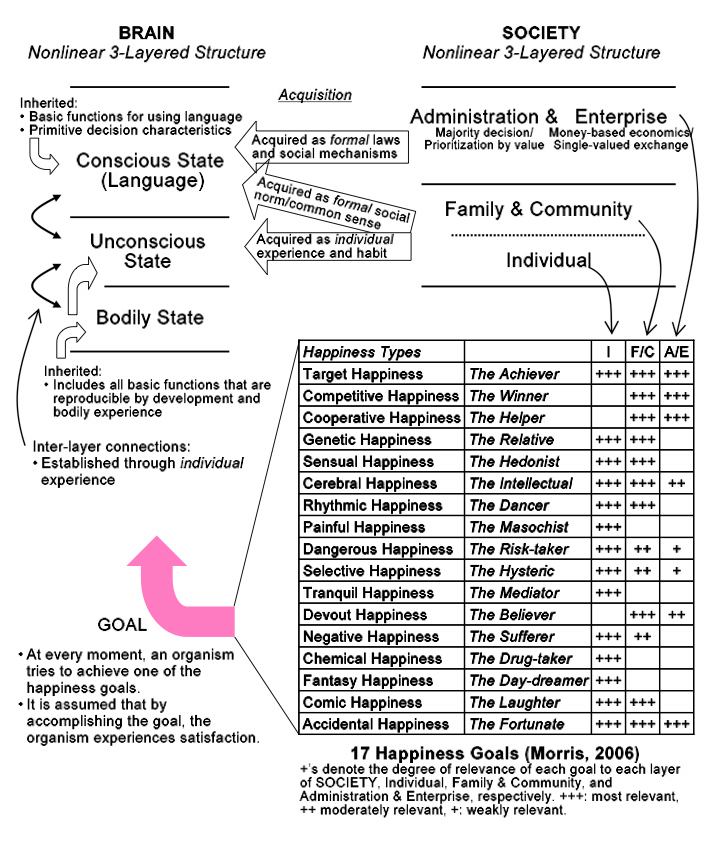|
|
|
-- Kitajima, M., Shimada, H., & Toyota, M. (2007)Kitajima, M., Shimada, H., & Toyota, M. (2007). MSA:Maximum Satisfaction Architecture: A Basis for Designing Intelligent Autonomous Agents on WEB 2.0. Proceedings of the 29th Annual Meeting of the Cognitive Science Society, 1790.
MSA:Maximum Satisfaction Architecture: A Basis for Designing Intelligent Autonomous Agents on WEB 2.0With the advance of the Internet, we, human beings, will become more networked and will have to live together with a number of intelligent autonomous agents. WEB 2.0 is the symbolic term to refer to this trend. The agents would have a variety of purposes but their ultimate goal would be to achieve human beings�f better living. However, useful models for designing such agents have not been provided in the research disciplines, such as Cognitive Sciences, Information Technology, and so on. This is mainly because traditional linear and reductionistic approaches would not be appropriate for modeling human beings, or brains, which exhibit a multi-layered structure with nonlinear interconnections (Prigogine, 1997). Nonlinearity means two important things that affect development of individual brain -- society system: 1) a fluctuation of the system caused by an environmental change would trigger creation of a new order or catastrophe, and 2) a small variation in the initial condition, during one�fs infant period, would develop exponentially as one grows up, which is called as Sensitive Dependence on Initial Condition (SEDIC). This paper proposes Maximum Satisfaction Architecture (MSA), which consists of three parts: human brain, society, and happiness goals, i.e., basic living purposes of human beings (Figure 1), with the aim of providing a basis for designing intelligent autonomous agents that contribute to realizing better living. MSA assumes that human brain pursues one of the seventeen happiness goals defined by Morris (2006) at every moment, and switches when appropriate by evaluating the current circumstances. Each of the happiness goals is associated with one or multiple layers of SOCIETY, Individual, Family and Community, and Administration and Enterprise. These layers have evolved from the history of human beings. Each layer is associated with its own value reflecting historical development, and thus different sets of happiness goals are relevant. The knowledge necessary to achieve the happiness goals is partly acquired and partly inherited. At the level of Conscious State, such knowledge as formal laws and social mechanisms necessary to deal with administration and enterprise, and formal social norms and common sense to deal with family and community and individual are acquired, whereas such knowledge as basic functions for using language and primitive decision characteristics are inherited. Similarly, at the level of Unconscious State, such knowledge as individual experience and habit is acquired to deal with family and community and individual. However, as opposed to the inherited knowledge at the Conscious State layer, all basic functions that are reproducible by development and bodily experience are inherited at Unconscious State layer. The pieces of knowledge at each layer in brain are nonlinearly interconnected through individual experience. This implies that individuals that pursue a same goal might have different patterns of activated networks because of SEDIC, and thus the processes to achieve the goal might be different. An intelligent autonomous agent must be sensitive to the individual differences in the processes to achieve a goal and provide sophisticated support for them to achieve it. The main functions of an MSA-based intelligent autonomous agent that aids the achievement of a happiness goal would include 1) promoting a state in the unconscious state layer to a state in�@the conscious state layer,2) supporting decision making, and 3) activating interaction between the conscious state layer and the unconscious state layer. Application of MSA for designing an intelligent autonomous agent for supporting satisfactory driving is on-going in our laboratory. Figure 1: Maximum Satisfaction Architecture (MSA) 
References
Download
|